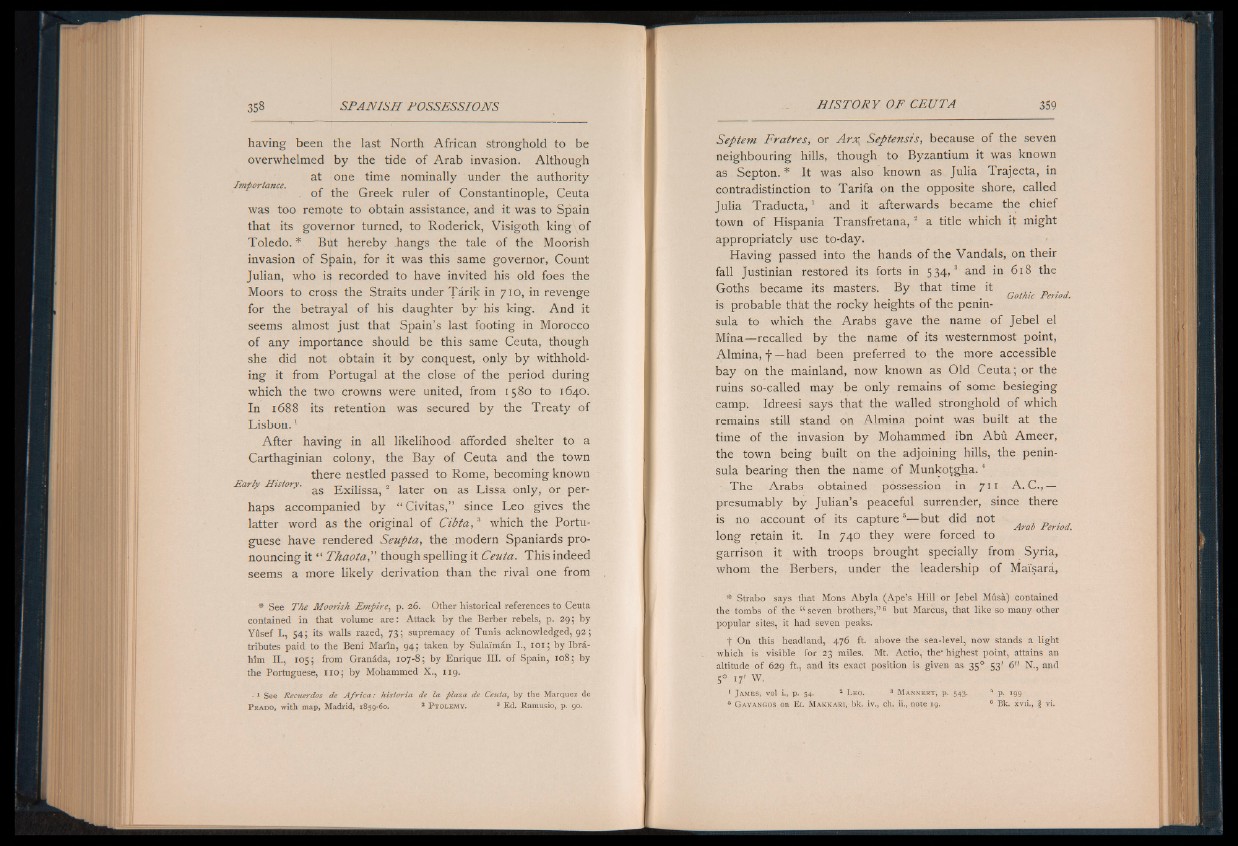
having been the last North African stronghold to be
overwhelmed by the tide of Arab invasion. Although
at one time nominally under the authority
of the Greek ruler of Constantinople, Ceuta
was too remote to obtain assistance, and it was to Spain
that its governor turned, to Roderick, Visigoth king \ of
Toledo. * But hereby .hangs the tale of the Moorish
invasion of Spain, for it was this same governor, Count
Julian, who is recorded to have invited his old foes the
Moors to cross the Straits under Tarik in 710, in revenge
for the betrayal of his daughter b y his king. And it
seems almost just that Spain’s last footing in Morocco
of any importance should be this same Ceuta, though
she did not obtain it by conquest, only by withholding
it from Portugal at the close of the period during
which the two crowns were united, from 1580 to 1640.
In 1688 its retention was secured by the Treaty of
Lisbon.1
After having in all likelihood afforded shelter to a
Carthaginian colony, the Bay of Ceuta and the town
there nestled passed to Rome, becoming known
Early History. „ .... „ . , T . ,
as Exilissa," later on as Lissa only, or perhaps
accompanied by “ Civitas,” since Leo gives the
latter word as the original of Cibta, * which the Portuguese
have rendered Seupta, the modern Spaniards pronouncing
it “ Thaota," though spelling it Ceuta. This indeed
seems a more likely derivation than the rival one from
* See The Moorish Empire, p. 26. Other historical references to Ceuta
contained in that volume are: Attack by the Berber rebels, p. 29; by
Yusef I., 54; its walls razed, 73; supremacy of Tunis acknowledged, 92;
tributes paid to the Beni Marin, 94; taken by Sula'imin I., 101; by Ibrd-
hlm II., 105; from Grandda, 107-8; by Enrique III. of Spain, 108; by
the Portuguese, n o ; by Mohammed X., 119.
• 1 See Reciterdos de A fr ica : historia de la plaza de Ceuta, by the Marquez de
P r a d o , with map, Madrid, 1859-60. 1 P t o l e m y . 3 Ed. Ramusio, p. 90.
Septem Fratres, or Arx, Septensis, because of the seven
neighbouring hills, though to Byzantium it was known
as Septon. * It was also known as Julia Trajecta, in
contradistinction to Tarifa on the opposite shore, called
Julia Traducta,1 and it afterwards became the chief
town of Hispania Transfretana,2 a title which it might
appropriately use to-day.
Having passed into the hands of the Vandals, on their
fall Justinian restored its forts in 5 34,3 and in 618 the
Goths became its masters. By that time it * . „ .
Gothic Period.
is probable thht the rocky heights of the peninsula
to which the Arabs gave the name of Jebel el
Mina— recalled by the name of its westernmost point,
Almina, f —had been preferred to the more accessible
bay on the mainland, now known as Old Ceuta; or the
ruins so-called may be only remains o f some besieging
camp. Idreesi says that the walled stronghold of which
remains still stand on Almina point was built at the
time of the invasion by Mohammed ibn Abu Ameer,
the town being built on the adjoining hills, the peninsula
bearing then the name of Munkotgha.4
The Arabs obtained possession in 711 A. C .,—
presumably by Julian’s peaceful surrender, since there
is no account of its capture5— but did not
Arab Period.
long retain it. In 740 they were forced to
garrison it with troops brought specially from Syria,
whom the Berbers, under the leadership of Maisara,
* Strabo says that Mons Abyla. (Ape’s Hill or Jebel Musa) contained
the tombs of the “ seven brothers,” 6 but Marcus, that like so many other
popular sites, it had seven peaks.
f On this headland, 476 ft. above the sea-level, now stands a light
which is visible for 23 miles. Mt. Actio, the- highest point, attains an
altitude of 629 ft., and its exact position is given as 350 531 6" N., and
5° 17' W.
1 J am e s , v o l i., p. 54. 2 L e o . 3 M a n n e r t , p. 543. k p. 199
5 G a y a n g o s o n E l M a k k a r i , bk. iv ., ch . ii., n o te 19. 6 Bk. x v i i ., § v i.